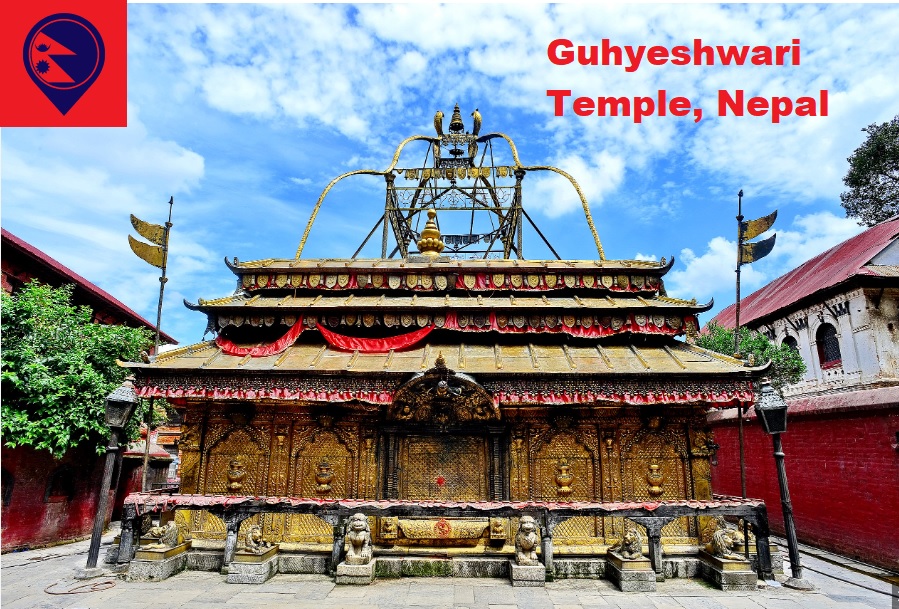Nestled on the banks of the holy Bagmati River in Kathmandu, the Guhyeshwari Temple stands as a revered pilgrimage site for Hindu devotees. This ancient temple, dedicated to Goddess Guhyeshwari, an incarnation of Adi Shakti, holds immense religious significance and is a key landmark in Nepal’s rich spiritual landscape. In this blog, we will explore the history, architectural splendor, and cultural importance of the Guhyeshwari Temple.

Historical Significance
The Guhyeshwari Temple has a profound historical and mythological background. It is believed to have been constructed in the 17th century by King Pratap Malla, a devout ruler known for his contributions to the religious and cultural heritage of the Kathmandu Valley. However, the temple’s origins are rooted in ancient Hindu mythology. According to legends, the temple marks the site where the yoni (womb) of Goddess Sati, the consort of Lord Shiva, fell when her body was dismembered by Lord Vishnu’s Sudarshan Chakra. This event is part of the story of Sati’s self-immolation and the subsequent mourning and wanderings of Lord Shiva, which are central themes in Hindu mythology.
Architectural Splendor
The Guhyeshwari Temple is an exquisite example of traditional Nepalese architecture. The temple complex is adorned with intricate wood and stone carvings that depict various deities and mythological scenes. The sanctum sanctorum houses a sacred stone symbolizing the goddess’s yoni, which is the primary object of worship. The temple’s architecture reflects the artistic brilliance of the Newar craftsmen who have historically been the backbone of Nepalese architectural heritage.
The temple’s exterior is decorated with beautifully carved struts and toranas (gateways), showcasing the skills of ancient artisans. The pagoda-style structure, with its multi-tiered roofs, is a common architectural feature in Nepalese temples, blending seamlessly with the surrounding landscape.
Religious and Cultural Importance
Guhyeshwari Temple holds a special place in the hearts of Hindu devotees, particularly for followers of Shaktism, a sect that worships the divine feminine power. The temple is considered one of the Shakti Peethas, sacred sites associated with the goddess Shakti, and attracts pilgrims from across Nepal and India.
The temple is especially significant during the Dashain festival, one of Nepal’s major Hindu celebrations. During this festival, devotees flock to the temple to offer prayers and seek blessings from Goddess Guhyeshwari. The temple complex buzzes with religious fervor, and the air is filled with the sounds of hymns and chants.
In addition to its religious importance, the Guhyeshwari Temple plays a vital role in the local community’s cultural and social life. It is a center for various religious rituals, ceremonies, and cultural events. The temple’s serene and spiritual ambiance offers solace to those seeking a break from the hustle and bustle of everyday life.
Preservation and Conservation
Preserving the Guhyeshwari Temple is crucial for maintaining its historical and cultural legacy. The temple has faced challenges such as natural disasters and the effects of time. The earthquake of 2015, which caused significant damage across Nepal, also impacted the Guhyeshwari Temple. Restoration efforts have been undertaken to repair and conserve the temple, with support from both the government and various heritage conservation organizations.
Ensuring the temple’s longevity involves regular maintenance and community involvement. Local devotees and volunteers play an active role in preserving the temple’s sanctity and cleanliness, demonstrating their deep respect and reverence for this sacred site.
Conclusion
The Guhyeshwari Temple is more than just a religious monument; it is a symbol of Nepal’s rich cultural and spiritual heritage. Its historical significance, architectural beauty, and cultural importance make it a must-visit destination for anyone exploring the spiritual landscape of Kathmandu. As we admire the temple’s intricate carvings and soak in its serene atmosphere, we are reminded of the timeless legacy of devotion and artistry that the Guhyeshwari Temple represents.
By preserving and promoting the Guhyeshwari Temple, we not only honor our past but also pave the way for a vibrant and spiritually enriched future. Whether you are a pilgrim seeking divine blessings or a traveler eager to delve into Nepal’s cultural treasures, the Guhyeshwari Temple promises an enriching and unforgettable experience.







